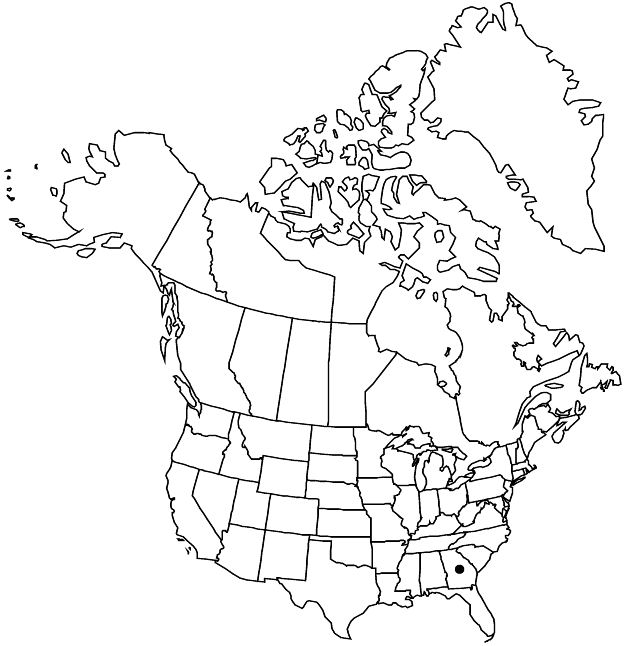Difference between revisions of "Crataegus exilis"
Biltmore Bot. Stud. 1: 76. 1902.
FNA>Volume Importer |
FNA>Volume Importer |
||
| Line 31: | Line 31: | ||
|distribution=Ga. | |distribution=Ga. | ||
|discussion=<p>Of conservation concern.</p><!-- | |discussion=<p>Of conservation concern.</p><!-- | ||
| − | --><p>Crataegus exilis is only known from the type locality in south-central Georgia. Its appearance is distinctive; unfortunately, it is known only from flowering and fruiting syntypes. The species is somewhat anomalous in ser. Lacrimatae and slightly resembles a larger C. calva (ser. Apricae) but has pilose inflorescence branches, slightly different leaf shape, and somewhat different leaf margins.</p> | + | --><p><i>Crataegus exilis</i> is only known from the type locality in south-central Georgia. Its appearance is distinctive; unfortunately, it is known only from flowering and fruiting syntypes. The species is somewhat anomalous in ser. Lacrimatae and slightly resembles a larger C. calva (ser. Apricae) but has pilose inflorescence branches, slightly different leaf shape, and somewhat different leaf margins.</p> |
|tables= | |tables= | ||
|references= | |references= | ||
| Line 55: | Line 55: | ||
|publication year=1902 | |publication year=1902 | ||
|special status=Conservation concern;Endemic | |special status=Conservation concern;Endemic | ||
| − | |source xml=https://jpend@bitbucket.org/aafc-mbb/fna-data-curation.git/src/ | + | |source xml=https://jpend@bitbucket.org/aafc-mbb/fna-data-curation.git/src/8f726806613d60c220dc4493de13607dd3150896/coarse_grained_fna_xml/V9/V9_1086.xml |
|subfamily=Rosaceae subfam. Amygdaloideae | |subfamily=Rosaceae subfam. Amygdaloideae | ||
|tribe=Rosaceae tribe Gillenieae | |tribe=Rosaceae tribe Gillenieae | ||
Revision as of 18:14, 18 September 2019
Shrubs, 20–40 dm, branches ± weeping. Stems: trunk bark dark gray or brownish, rough; upper twigs suberect, others ± spreading; twigs slightly flexuous, new growth pubescent, 1-year old light gray-brown, older gray-brown; thorns on twigs few, straight, dark, 1–1.5 cm. Leaves: petiole length 25–30% blade, winged distally, pubescent young, glandularity not recorded; blade broadly obovate to broadly rhombic-elliptic, the smaller ± oblong-cuneate, 1.5–2.5(–3) cm, firm to subcoriaceous, base tapered, lobes 0, or 1(or 2) per side, subterminal, sinuses shallow (LII to 10%), lobe apex subacute, margins crenate-serrate (distal 1/2), veins 3 per side, apex subacute, surfaces pubescent young, particularly abaxially on veins, glabrescent; on extension shoots deeply incised. Inflorescences 3–7-flowered; branches pilose-pubescent; bracteoles oblong-linear, margins glandular. Flowers 15 mm diam.; hypanthium pilose; sepals narrowly triangular, 3–4 mm, margins subentire or finely glandular-serrate, abaxial pubescence not recorded; anthers cream or ivory; styles 3–5. Pomes red, orbicular, 5–7 mm diam., glabrous; sepals usually erose; pyrenes 3–5.
Phenology: Flowering Mar–Apr; fruiting Aug–Sep.
Habitat: Sandy soil, stream banks
Elevation: 60 m
Discussion
Of conservation concern.
Crataegus exilis is only known from the type locality in south-central Georgia. Its appearance is distinctive; unfortunately, it is known only from flowering and fruiting syntypes. The species is somewhat anomalous in ser. Lacrimatae and slightly resembles a larger C. calva (ser. Apricae) but has pilose inflorescence branches, slightly different leaf shape, and somewhat different leaf margins.
Selected References
None.
